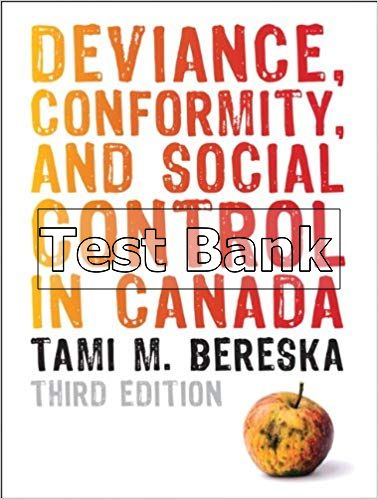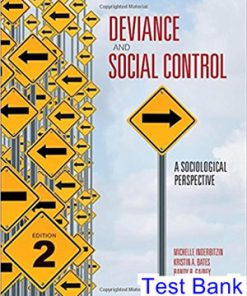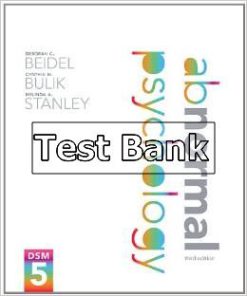Deviance Conformity and Social Control in Canada 3rd Edition Bereska Test Bank
$50.00 Original price was: $50.00.$26.50Current price is: $26.50.
Deviance Conformity and Social Control in Canada 3rd Edition Bereska Test Bank.
Deviance Conformity and Social Control in Canada 3rd Edition Bereska Test Bank

Product details:
- ISBN-10 : 0132459310
- ISBN-13 : 978-0132459310
- Author: Bereska, Tami M.
Deviance, Conformity, and Social Control in Canada is a broad, critical introduction to the study of deviance. Theories are covered in two early chapters, and Bereska then devotes the rest of the text to substantive issues of particular interest to students. These chapters present topics that arise in everyday situations that are relevant to students’ lives, and include new sections on youth, science and physical appearance. Each topic is placed within a socio-cultural context and contributes to a bigger picture. Both criminal and non-criminal forms of deviance are discussed in each chapter, and the role of power in the social construction of deviance explored.
Table contents:
- Chapter 1 Introduction to Deviance
- ▶ Public Nudity
- Introduction
- Conceptions of Deviance
- ▶ Be Careful Who You Are Calling Deviant: Body Rituals Among the Nacirema
- The Sociological Imagination
- ▶ How Do You Define Deviance?
- The Importance of Theory and Its Relationship to Research
- ▶ Deviance in Popular Culture
- ▶ The Poverty of the Sociology of Deviance: Nuts, Sluts, and Preverts
- Global Perspectives on Deviance
- Deviance and Disparity
- Ideas in Action
- Conclusion: Organization of the Book
- ▶ Now You . . . Use Your Sociological Imagination
- Exercises and Discussion Questions
- Key Terms
- ▶ Readings
- 1.1. When the Personal Is Political—and Infectious
- 1.2. The Mystification of Social Deviance
- Chapter 2 The Diversity of Deviance
- ▶ The Most Tattooed Man in the World
- Introduction
- Deviance and Its Varied Forms
- ▶ Strict Conformity as Deviance
- Physical Deviance and Appearance: Ideals of Beauty, Self-Harm, and Body Modification
- ▶ Deviance in Popular Culture
- Relationships and Deviance
- Deviance in Cyberspace: Making Up the Norms as We Go
- Subcultural Deviance
- Elite Deviance, Corporate Deviance, and Workplace Misconduct
- Positive Deviance
- Global Perspectives on Types of Deviance
- Social Control of Girls and Women
- Social Control of Homosexuality
- Deviance and Disparity: Differential Treatment in Dealing With Addiction, Prostitution, and Graffiti
- Drug Use and Addiction
- Prostitution
- Graffiti
- Ideas in Action: Guerrilla Gardening in Low-Income Areas
- ▶ Now You . . . Try an Experiment in Positive Deviance!
- Question: So Who Are the Deviants? Answer: It Depends on Whom You Ask
- Conclusion
- Exercises and Discussion Questions
- Key Terms
- ▶ Readings
- 2.1. Love Me Tinder, Love Me Sweet: Reshaping the College Hookup Culture
- 2.2. Corporate Transgressions Through Moral Disengagement
- Chapter 3 Researching Deviance
- ▶ Three Research-Related Stories From the Authors
- Introduction
- Methodological Approaches to Studying Deviance
- Experiments in the Study of Deviance
- ▶ Deviance in Popular Culture
- Large-Scale Survey Research
- Field Research: Pure Observer to Full Participant
- Content Analysis
- Secondary Data Sources
- The Uniform Crime Report and the National Incident-Based Reporting System
- Substance Abuse and Mental Health Services Administration
- Monitoring the Future
- Archived Data: Inter-university Consortium for Political and Social Research
- Ethical Considerations in Studying Deviance
- Global Perspectives on Trials and Tribulations Involved in Researching Deviance Across the Globe
- Deviance and Disparity: Regulation of Smoking
- Ideas in Action: Evaluating Programs and Policy
- ▶ Now You . . . Think About the Data
- Conclusion
- Endnote
- Exercises and Discussion Questions
- Key Terms
- ▶ Readings
- 3.1. The Promise and Pitfalls of Going Into the Field
- 3.2. Misogyny in Rap Music: A Content Analysis of Prevalence and Meanings
- Chapter 4 Anomie/Strain Theory
- ▶ Retreating Into the Wild
- Introduction
- Development of Anomie/Strain Theory
- Émile Durkheim and Anomie
- Robert Merton and Adaptations to Anomie/Strain
- Merton’s Adaptations to Anomie
- Richard Cloward and Lloyd Ohlin, Differential Opportunity
- ▶ Deviance in Popular Culture
- Albert Cohen, Delinquent Boys
- Robert Agnew, General Strain Theory
- Messner and Rosenfeld, Crime and the American Dream—Institutional Anomie Theory
- Application of Anomie and Strain Theories
- Anomie and the Abuse at Abu Ghraib
- The American Dream and Incarcerated Young Men
- Institutional Anomie Theory and Student Cheating
- Critiques of Anomie and Strain Theories
- Global Perspectives on Anomie/Strain Theory
- Deviance and Disparity: The Occupy Wall Street Movement
- Ideas in Action: Transforming Innovation Into Conformity and Legitimate Success
- ▶ Now You . . . Use the Theory
- Conclusion
- Exercises and Discussion Questions
- Key Terms
- ▶ Readings
- 4.1. Durkheim’s “Suicide” in the Zombie Apocalypse
- 4.2. A General Strain Theory of Terrorism
- Chapter 5 Social Disorganization Theory
- ▶ “When the Towers Come Down”
- Introduction
- ▶ Deviance in Popular Culture
- Development of Social Disorganization Theory
- Shaw and McKay’s Study of Juvenile Delinquency and Urban Areas
- Early Critiques of Social Disorganization Theory
- Rebirth of Social Disorganization Theory
- Empirical Tests of Social Disorganization Theory
- Economic Deprivation: Direct and Indirect Effects
- Collective Efficacy as a Key Theoretical and Empirical Element of Social Disorganization Theory
- Global Perspectives on Social Disorganization Theory
- Tests of Social Disorganization in Cities Outside the United States
- More Theoretical and Empirical Advances and Divergences
- Social and Physical Disorder
- Deviance and Disparity: Social Disorganization Theory
- External Forces in the Creation of Social Disorganization
- Social Disorganization From Impoverished Neighborhoods to White-Collar and State Crime
- Ideas in Action: Programs and Policy From Social Disorganization and Broken Windows Perspectives
- ▶ Now You . . . Use the Theory
- Conclusion
- Exercises and Discussion Questions
- Key Terms
- ▶ Readings 212
- 5.1. Fences and Neighbors: Segregation in 21st-Century America
- 5.2. Segregation and Violence Reconsidered: Do Whites Benefit From Racial Segregation?
- Chapter 6 Differential Association and Social Learning Theories
- ▶ Anorexia, Bulimia, and the World Wide Web
- Introduction
- Development of Differential Association Theory
- ▶ Deviance in Popular Culture
- Development of Akers’s Social Learning Theory
- Techniques of Neutralization
- Social Structure and Social Learning
- Empirical Tests of Akers’s Social Structure Social Learning Theory
- Application of Differential Association and Social Learning
- Critiques of Differential Association and Social Learning Theories
- Cultural Deviance Theory and Subcultural Explanations of Deviance
- Deviance and Disparity: Can Differential Association/Social Learning Theories Explain Gender Disparities in Deviance?
- Ideas in Action: Programs and Policy From a Social Learning Perspective
- ▶ Now You . . . Use the Theory
- Global Perspectives on Testing Differential Association and Social Learning Theories Outside of the United States
- Conclusion
- Exercises and Discussion Questions
- Key Terms
- ▶ Readings
- 6.1. Learning From Drag Queens
- 6.2. Parents and Partners: Moderating and Mediating Influences on Intimate Partner Violence Across Adolescence and Young Adulthood
- Chapter 7 Social Control Theories of Deviance
- ▶ Social Media Disasters
- Introduction
- Development of Social Control Theory
- Nye
- Hirschi
- ▶ Deviance in Popular Culture
- Contemporary Additions to Social Control Theory
- Power-Control Theory
- Theory of Self-Control
- Life Course Theory
- Application of Social Control Theories
- Critiques of Social Control Theories
- Global Perspectives on Deviance and Social Control Theories
- Deviance and Disparity: The Cases of Teenage Homelessness
- Teenage Runaways and Throwaways
- Teenage Runaways and Throwaways and Social Control Theory
- Ideas in Action: Homeboy Industries
- ▶ Now You . . . Use the Theory
- Conclusion
- Exercises and Discussion Questions
- Key Terms
- ▶ Readings
- 7.1. “Children” Having Children
- 7.2. Self-Control, Opportunity, and College Students’ Bystander Intervention in Sexually Coercive Situations
- Chapter 8 Labeling Theory
- ▶ What If Harry Potter Had Been Sorted Into Slytherin?
- Introduction
- Development of Labeling Theory
- How the Labeling Process Works
- Labeling and Mental Illness
- ▶ Deviance in Popular Culture
- Labeling and Delinquency
- Application of Labeling Theory
- Braithwaite (1989), Crime, Shame and Reintegration
- Matsueda (1992), “Reflected Appraisals, Parental Labeling, and Delinquency”
- Rosenfield (1997), “Labeling Mental Illness”
- Davies and Tanner (2003), “The Long Arm of the Law: Effects of Labeling on Employment”
- Lee and Bubolz (2020), “The Gang Member Stands Out: Stigma as a Residual Consequence of Gang Involvement”
- Lageson and Maruna (2018), “Digital Degradation: Stigma Management in the Internet Age”
- Impact of Labeling Theory
- Critiques of Labeling Theory
- ▶ Defining Oneself as Deviant
- Global Perspectives on Labeling Theory
- Social Control of Mental Illness
- Deviance and Disparity: When Is Drinking—or Not Drinking—Deviant on College Campuses?
- Ideas in Action: The “I Have a Dream” Foundation—Instilling Positive Labels
- ▶ Now You . . . Use the Theory
- Conclusion
- Exercises and Discussion Questions
- Key Terms
- ▶ Readings
- 8.1. Life After Deportation
- 8.2. Digital Degradation: Stigma Management in the Internet Age
- Chapter 9 Marxist and Conflict Theories of Deviance
- ▶ Transgender Rights
- Introduction
- Development of Marxist Theory
- Conflict
- Dialectical Materialism
- Marxism and the Creation of Law and Deviance
- ▶ Deviance in Popular Culture
- Development of Conflict Theory
- Gusfield
- Vold
- Turk
- Quinney
- Chambliss
- Applications of Marxist and Conflict Theories
- Critiques of Marxist and Conflict Theories
- Global Perspectives on Deviance and Marxist/Conflict Theories
- Critical Collective Framing Theory and the Genocide in Darfur
- Deviance and Disparity: Voting Rights, Voter Suppression, Gerrymandering, and Social Media
- Voter Suppression and Conflict Theory
- Ideas in Action: Voter Registration Drives
- ▶ Now You . . . Use the Theory
- Conclusion
- Exercises and Discussion Questions
- Key Terms
- ▶ Readings
- 9.1. Prison Tourism in the Age of Mass Incarceration
- 9.2. The Spawn of Slavery: The Convict-Lease System in the South
- Chapter 10 Critical Theories of Deviance
- ▶ The #MeToo Movement
- Introduction
- Development of Feminist Criminology
- Feminist Theory, Homelessness, and Sexual Assault
- ▶ Deviance in Popular Culture
- Development of Critical Race Theory
- Critical Race Theory and the #MeToo Movement
- Development of Peacemaking
- Peacemaking and Homelessness
- Critiques of Critical Theories
- Global Perspectives on Deviance and Critical Theories
- Social Control and Reintegration: Restorative Justice
- Deviance and Disparity: Human Trafficking—Crossing Boundaries and Borders
- Ideas in Action: What Can Be Done About Human Trafficking?
- ▶ Now You . . . Use the Theory
- Conclusion
- Exercises and Discussion Questions
- Key Terms
- ▶ Readings
- 10.1. Freedom and the Iranian Women’s Movement
- 10.2. The Differential Representation of Latina and Black Female Victims in Front-Page News Stories: A Qualitative Document Analysis
- Chapter 11 Societal Responses to Deviance
- ▶ Life as a Convicted Felon
- Introduction
- Medicalization of Deviant Behavior
- Policing, Supervision, and the Impact of Incarceration on Disadvantaged Populations and Communities
- Total Institutions
- ▶ Deviance in Popular Culture
- Correctional Facilities and the Purposes of Punishment
- Gresham Sykes and the Pains of Imprisonment
- Juvenile Correctional Facilities
- Reentry: Challenges in Returning to the Community After Time in an Institution
- Felon Disenfranchisement
- Public Fear and Social Control: The Case of Sex Offenders
- Collateral Consequences: Effects on Communities and Families
- Global Perspectives on the Social Control of Deviance
- Social Control of Crime: Extremes in Prison Conditions Internationally
- Deviance and Disparity: How Money Can Matter in Local Jails
- Ideas in Action: College Programs in Prisons
- ▶ Now You . . . Think About Social Control
- Conclusion
- Exercises and Discussion Questions
- Key Terms
- ▶ Readings
- 11.1. Desperation and Service in the Bail Industry
- 11.2. Lessons From a Juvenile Training School: Survival and Growth
- Chapter 12 Deviant Careers and Career Deviance
- ▶ Shared Beginnings, Divergent Outcomes
- Introduction
- ▶ Deviance in Popular Culture
- Development of a Deviant Career and Career Deviance Approach
- Getting Into Deviance: Onset of a Deviant Career
- Risk and Protective Factors for Onset
- Escalation, Persistence, and Specialization in Deviance
- Sex Offenders: Generalists or Specialists?
- The Case of Drinking and Driving
- Specialization and General Deviance Is Not Always a Choice
- Summary of Career Deviance: Specialists or Generalists?
- Getting Out of the Game: Desistance From Career Deviance
- Deviance and Disparity: Alcohol Use and Misuse Disparities Among Heterosexual and Sexual Minority Youth
- Global Perspectives on Cross-Cultural Interest in Deviant Careers and Career Deviance
- Ideas in Action: Programs and Policy From a Career Deviance and Deviant Career Perspective
- ▶ Now You . . . Think About Deviant Careers
- Conclusion
- Exercises and Discussion Questions
- Key Terms
- ▶ Readings
- 12.1. The Sex Lives of Sex Researchers
- 12.2. Military Service: A Pathway to Conformity or a School for Deviance?
- Glossary
- References and Additional Reading
- Index
People also search:
deviance and social control 3rd edition pdf
deviance and social control 3rd edition
deviance crime and social control pdf
deviance crime and control 3rd edition pdf
deviance conformity and social control in canada
Instant download after Payment is complete
You may also like…
Canadian
Deviance Conformity and Social Control in Canada Canadian 4th Edition Bereska Solutions Manual
Solutions Manual
Community Health Nursing in Canada 3rd Edition Stanhope Test Bank




















